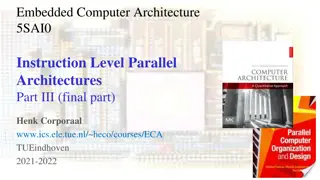Understanding Gamification in Education Through Gaming Principles
Delve into the world of gamification in education with a focus on gaming principles used to enhance learning experiences. Explore the concept of gamification, its benefits, and why individuals are motivated to keep playing games. Discover the role of dopamine in gaming and ways to boost its levels through specific activities. Engage in interactive activities to grasp the essence of gamification and its impact on educational settings.
Download Presentation

Please find below an Image/Link to download the presentation.
The content on the website is provided AS IS for your information and personal use only. It may not be sold, licensed, or shared on other websites without obtaining consent from the author. Download presentation by click this link. If you encounter any issues during the download, it is possible that the publisher has removed the file from their server.
E N D
Presentation Transcript
GAMIFICATION IN EDUCATION
WELCOME o Facilitator name Position at university Contact info
LEARNING OUTCOMES By the end of this module, you should be able to: o Explain what gamification means o Describe several gaming principles used in education
AGENDA Game time! What is gamification? Gaming principles in learning 1. 2. 3. Note: Part of this module is based on the TEDx talk Neuroscience Pathways From Lab To Classroom by Dr. Judy Willis.
A PLAYER USUALLY o Gets and uses ongoing, immediate feedback to improve performance o Learns from their mistakes o Feels pleasure when achieving a challenge and progressing to the next level o Keeps playing even when the failure rate is 80% o Is motivated by the reward of a more difficult challenge
DOPAMINE o Pleasure o Decreased stress o Curiosity o Attention o Motivation
DOPAMINE BOOSTERS o Movement o Humour o Choice o Optimistic thoughts o Intrinsic satisfaction of making a correct prediction
QUESTION 1: PREDICT o Is it more probable that one would get killed by a shark or die from an asteroid or comet? Write SHARK or COMET and hold up your answer
QUESTION 2: ESTIMATE o ESTIMATE the odds of getting killed by a shark and dying from an asteroid or comet Write: o Shark 1 in o Comet 1 in Hold up your answer.
SOLVING PROBLEMS o Boosts self-confidence and satisfaction o Improves perseverance and time on task
HERE IT IS! o Odds of getting killed by a shark: 1 in 3.7 million o Odds of dying from an asteroid or comet: between 1 in 3,000 and 1 in 250,000 Source: http://news.nationalgeographic.com/news/2013/12/131219-lottery-odds-winning-mega- million-lotto/
GAMING PRINCIPLES IN LEARNING o Provide specific, achievable challenges o Incorporate frequent assessment and feedback o Award points for success o Promote awareness of incremental progress o Allow for mistakes without penalty o Individualize learning
GAMING PRINCIPLES IN LEARNING In every job that must be done, there is an element of FUN! You find the fun, and snap! The job s a GAME! Mary Poppins A Spoonful of Sugar (1964)
GAMING PRINCIPLES: ONLINE TEACHING o Let students choose their learning paths and work at their own pace o Create practice problems with immediate, adaptive feedback and tailored suggestions o Provide opportunities for students to practice in a low-stress environment to improve learning
GAMING PRINCIPLES IN LEARNING Video o Applying gaming principles to educational contexts
GROUP DISCUSSION o Do you find that you already use some of the gaming principles in your course design? o If not, would you consider using some of these principles in order to enhance engagement and motivation of your students? Why or why not?
SUMMARY o Gamification involves using the same kinds of thinking and processes that drive games, but in a non-gaming context o The reward for game playing is intrinsic o Applying gaming principles to courses may increase student engagement and motivation
THANK YOU o Questions? o Comments? o Help? Contact information facilitator s and departmental
REFERENCES Coppens, A., Hughes, A., Andrews, A. Meredith, A.L., Austin, B., Bowen, J., Kunkel, V. (n.d.) How gamification reshapes learning: free ebook. Retrieved from http://elearningindustry.com/how- gamification-reshapes-learning. TedX Talks. (2011, March 9). Let s use video to reinvent education. Retrieved April 9, 2014, from http://www.ted.com/talks/ salman_khan_let_s_use_video_to_reinvent_education. TedX Talks. (2012, April 28). Neuroscience Pathways From Lab To Classroom: TEDx talk by Dr. Judy Willis. Retrieved April 9, 2014, from http://www.youtube.com/watch?v=WHRyPbcLKis. 1. 2. 3.























